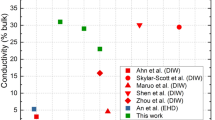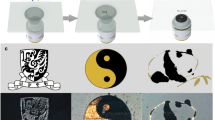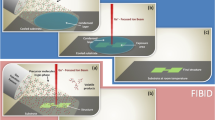Abstract
Electrical connections in microelectronics are usually established by means of photolithography to define the conducting channels. But methods that do not involve lithography have been explored, such as the use of electrodeposition1 or electropolymerization2,3,4,5,6 to grow random structures of conducting material between two electrodes. This approach has been used to make diodes, transistors and signal amplifiers based on conducting polymers2,3. Template-based7,8,9,10,11,12 and thermal plating13 strategies have also been used to direct the growth of electrically conducting media. One advantage of these approaches over photolithography is the possibility of forming contacts in three dimensions and so achieving enhanced data-processing densities. Previous electrochemical approaches have required that the electrodes to be connected are physically linked to the external voltage source. Here we show that electrodissolution and electrodeposition processes in an applied electric field can be exploited to create directional growth of copper deposits between copper particles that are not connected to an external circuit. Moreover, the particles distort the electric field in such a way as to focus the diffusion of copper ions and consequently the direction of ‘wire’ growth, enabling the particles to be connected to one another in a directional and controllable manner. This suggests that appropriately directed electric fields may be used to connect an array of such particles into an arbitrary circuit pattern.
This is a preview of subscription content, access via your institution
Access options
Subscribe to this journal
Receive 51 print issues and online access
$199.00 per year
only $3.90 per issue
Buy this article
- Purchase on Springer Link
- Instant access to full article PDF
Prices may be subject to local taxes which are calculated during checkout




Similar content being viewed by others
References
Gurtner, C. & Sailor, M. J. Selective construction of electrical connections using an organic charge transfer salt. Adv. Mater. 8, 897–899 (1996).
McCoy, C. H. & Wrighton, M. S. Potential dependent conductivity of conducting polymers yields opportunities for molecule based devices—a microelectrochemical push–pull amplifier based on 2 different conducting polymer transistors. Chem. Mater. 5, 914–916 (1993).
Jones, E. T. T., Chyan, O. M. & Wrighton, M. S. Preparation and characterisation of molecule-based transistors with a 50-nm source-drain separation with use of shadow deposition techniques—toward faster, more sensitive molecule-based devices. J. Am. Chem. Soc. 109, 5526–5528 (1987).
Sailor, M. J. & Curtis, C. L. Conducting polymer connections for molecular devices. Adv. Mater. 6, 688–692 (1994).
Fujii, M., Arii, K. & Yoshino, K. Neuron-type polypyrrole device prepared by electrochemical polymerization method and its properties. Synth. Met. 71, 2223–2224 (1995).
Curtis, C. L., Ritchie, J. E. & Sailor, M. J. Fabrication of conducting polymer interconnects. Science 262, 2014–2016 (1993).
Hidber, P. C., Nealey, P. F., Helbig, W. & Whitesides, G. M. New strategy for controlling the size and shape of metallic features formed by electroless deposition of copper—microcontact printing of catalysts on oriented polymers, followed by thermal shrinkage. Langmuir 12, 4209–5215 (1996).
Chou, S. Y., Krauss, P. R. & Renstrom, P. J. Imprint lithography with 25-nanometer resolution. Science 272, 85–87 (1996).
Wang, L., Yu-Zhang, K., Metrot, A., Bonhomme, P. & Troyon, M. TEM study of electrodeposited Ni/Cu multilayers in the form of nanowires. Thin Solid Forms 288, 86–89 (1996).
Masuda, H. & Fukuda, K. Ordered metal nanohole arrays made by a 2-step replication of honeycomb structures of anodic alumina. Science 268, 1466–1468 (1995).
Martin, C. R. Nanomaterials—a membrane-based synthetic approach. Science 266, 1961–1966 (1994).
Huber, C. A. et al. Nanowire array composites. Science 263, 800–802 (1994).
Von Gutfeld, R. J. & Vigliotti, D. R. Copper microcircuit repair of opens using thermally driven exchange plating. Appl. Phys. Lett. 56, 2584–2586 (1990).
Lee, J. K., Shemilt, L. W. & Chun, H. S. Studies of bipolarity in fluidized-bed electrodes. J. Appl. Electrochem. 19, 877–881 (1989).
Kusakabe, K., Kimura, T., Morooka, S. & Kato, Y. Recirculating feed operation of bipolar packed-bed and trickle-bed electrode cells equipped with mesh spacers. J. Appl. Electrochem. 17, 724–730 (1987).
Plimley, R. E. & Wright, A. R. Abipolar mechanism for charge transfer in a fluidized bed electrode. Chem. Eng. Sci. 39, 395–405 (1984).
Handley, D. & Eardley, D. C. Bipolar electrolysis with intraphase conduction in fluidized beds. Chem. Ind. 330–332 (1975).
Sudoh, M., Kodera, T. & Ichino, T. Effect of oxygen sparging into packed-bed electrode on production rate of hydrogen peroxide. J. Chem. Eng. Jpn. 24, 165–170 (1991).
Manji, A. & Oloman, C. W. Electrosynthesis of propylene-oxide in a bipolar trickle-bed reactor. J. Appl. Electrochem. 17, 532–544 (1987).
Sudoh, M., Kodera, T., Hino, H. & Shimamura, H. Effect of anodic and cathodic reactions on oxidative-degradation of phenol in an undivided bipolar electrolyzer. J. Chem. Eng. Jpn. 21, 198–208 (1988).
Kim, H. J., Kusakabe, K., Hokazono, S., Morooka, S. & Kato, Y. Electro-oxidation rate of p-tertpbutyltoluene in a bipolar packed bed electrode cell. J. Appl. Electrochem. 17, 1213–1222 (1987).
Ghoroghchian, J., Pons, S. & Fleischmann, M. Gas-phase electrochemistry on dispersions of microelectrodes. J. Electroanal. Chem. 317, 101–108 (1991).
Rolison, D. R. Zeolite-modified electrodes and electrode modified zeolites. Chem. Rev. 90, 867–878 (1990).
Fleischmann, M., Ghoroghchian, J., Rolison, D. & Pons, S. Electrochemical-behavior of dispersions of spherical ultramicroelectrodes. J. Phys. Chem. 90, 6392–6400 (1986).
Bradley, J.-C., Guedeau-Boudeville, M.-A., Jandeau, G. & Lehn, J.-M. Toposomes bearing stable perforations by the action of an electric field on partially polymerized giant vesicles. Langmuir 13, 2457–2462 (1997).
Kirkova, L. & Rashkov, S. Anodic behavior of copper during electrorefining using a rotating ring-disc electrode. Appl. Electrochem. 24, 420–425 (1994).
Sawada, Y., Dougherty, A. & Gollub, J. P. Dendritic and fractal patterns in electrolytic metal depositions. Phys. Rev. Lett. 56, 1260–1263 (1986).
Fleury, V. & Barkey, D. Runaway growth in 2-dimensional electrodeposition. Europhys. Lett. 36, 253–258 (1996).
Bazant, M. Z. Regulation of ramified electrochemical growth by a diffusive wave. Phys. Rev. E 52, 1903–1914 (1995).
Cork, R. H., Pritchard, D. C. & Tam, W. Y. Local concentration measurements in electrochemical deposition using a schlieren method. Phys. Rev. A 44, 6940–6943 (1991).
Chazalviel, J. N. Electrochemical aspects of the generation of ramified metallic electrodeposits. Phys. Rev. A 42, 7355–7367 (1990).
Marshall, G. & Mocskos, P. Growth model for ramified electrochemical deposition in the presence of diffusion, migration, and electroconvection. Phys. Rev. E 55, 549–563 (1997).
Huang, W. G. & Hibbert, D. B. Fast fractal growth with diffusion, convection and migration by computer-simulation-effects of voltage of probability, morphology and fractal dimension of electrochemical growth in a rectangular cell. Physica A 233, 888–898 (1996).
Marshall, G., Tagtachian, S. & Lam, L. Growth-pattern formation in copper electrodeposition—experiments and computational modeling. Chaos, Solitons Fractals 6, 325–339 (1995).
Fleury, V., Kaufman, J. H. & Hibbert, D. B. Mechanism of a morphology transition in ramified electrochemical growth. Nature 367, 435–438 (1994).
Barkey, D. P., Watt, D., Liu, Z. & Raber, S. The role of induced convection in branched electrodeposit morphology selection. J. Electrochem. Soc. 141, 1206–1212 (1994).
Livermore, C. & Wong, P. Z. Convection and turbulence effects in strongly driven electrochemical deposition. Phys. Rev. Lett. 72, 3847–3850 (1994).
Fleury, V., Chazalviel, J. N. & Rosso, M. Coupling of drift, diffusion, and electroconvection, in the vicinity of growing electrodeposits. Phys. Rev. E 48, 1279–1295 (1993).
Halsey, T. C. Electrodeposition and diffusion-limited aggregation. J. Chem. Phys. 92, 3756–3767 (1990).
Garik, P. et al. Laplace-field-controlled and diffusion-field-controlled growth in electrochemical deposition. Phys. Rev. Lett. 62, 2703–2706 (1989).
Argoul, F., Arneodo, A., Grasseau, G. & Swinney, H. L. Self-similarity of diffusion-limited aggregates and electrodeposition clusters. Phys. Rev. Lett. 61, 2558–2561 (1988).
Sawada, Y., Dougherty, A. & Gollub, J. P. Dendritic and fractal patterns in electrolytic metal deposits. Phys. Rev. Lett. 56, 1260–1263 (1986).
Keh, H. J. & Li, W. J. Interactions among bipolar spheres in an electrolytic cell. J. Electrochem. Soc. 141, 3103–3114 (1994).
Acknowledgements
We thank J. Yuan, M. Vallieres and A. Nath for discussions. This work was supported by Drexel University.
Author information
Authors and Affiliations
Corresponding author
Rights and permissions
About this article
Cite this article
Bradley, JC., Chen, HM., Crawford, J. et al. Creating electrical contacts between metal particles using directed electrochemical growth. Nature 389, 268–271 (1997). https://doi.org/10.1038/38464
Received:
Accepted:
Issue Date:
DOI: https://doi.org/10.1038/38464
This article is cited by
-
High-performance Supercapacitors Based on Electrochemical-induced Vertical-aligned Carbon Nanotubes and Polyaniline Nanocomposite Electrodes
Scientific Reports (2017)
-
Electropolymerization on wireless electrodes towards conducting polymer microfibre networks
Nature Communications (2016)
-
Reduced Graphene Oxide Thin Film on Conductive Substrates by Bipolar Electrochemistry
Scientific Reports (2016)
-
Electrically induced reorganization phenomena of liquid metal film printed on biological skin
Applied Physics A (2016)
-
Filament growth dynamics in solid electrolyte-based resistive memories revealed by in situ TEM
Nano Research (2014)
Comments
By submitting a comment you agree to abide by our Terms and Community Guidelines. If you find something abusive or that does not comply with our terms or guidelines please flag it as inappropriate.



